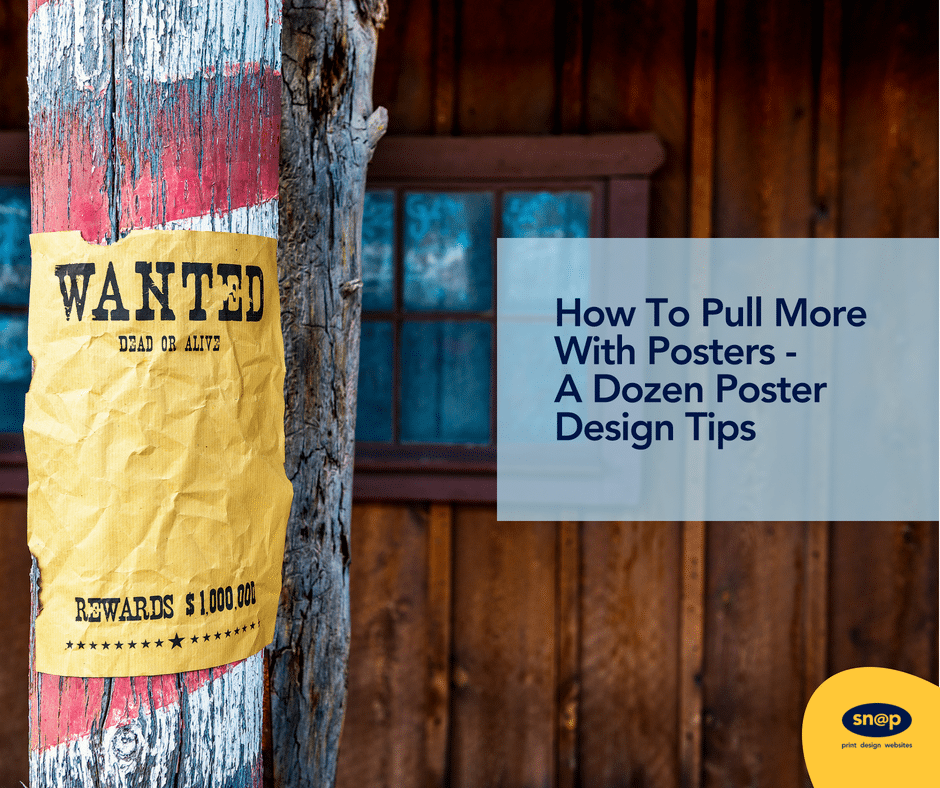Posters are one of the most powerful ways to announce a new idea, event or warning to a large number of people within a local area.
But much like a street sign, people are usually on the move or standing still for a short time – at a bus stop, in a store, waiting for a friend. That means posters need to make a big impact quickly.
When To Use a Poster
- Internally shout-out about your latest or business news to employees
- Promote events within venues and outdoors, to would-be punters.
- Announce an urgent safety message or specific instructions for operational reasons.
- Advertise sales and offers in the form of outdoor street billboards or as window displays and via point of sale.
- Decorate and brand a space or show some personality in your venue or space with strong graphic cues
- Showcase latest arrivals and more
The team at Snap have put together these tips to help you create posters that shine so bright, it makes the others fade into the background.
1. Start With A Great Idea
The message behind your poster design needs to reach your target audience without being vague or confusing.So before you begin designing your poster: It all starts with a great idea
- Come up with a unique idea that is still related to your brand.
- Be able to articulate the idea in as few words as possible
- Know what you want to achieve with you posters – calls, sales, attendance
2. Do Not Work With Flawed Copy
Well, before you begin designing make sure the copy and information you are representing is accurate, factually and grammatically. an obvious one but critical no doubt.
Keep it simple. Keep it clear.
3. Understand The Audience
Yes, we’re back to THIS a golden rule in marketing. Don’t make, do or send anything until you know who you are talking to. Nothing is as important for success as aligning your offering with what your audience wants to hear from you.
Tailor your offer, your message, design, etc to specific personas. Consider factors like age, income, location, problems, desires, etc. Otherwise, you’re literally talking in the wrong language.
The more you show people that you really know what matters to them, the more they’ll like you, trust you and want to do business with you. This impacts everything, including the poster design and its message. For example, what is going to work for a youth rock concert is unlikely to work for a business conference.
You should at least know:
- Who are they?
- Where they’re from?
- What do they do?
- How you can help them
4. Define A Focal Point
The creative element and idea of your poster is what gets attention, intrigues and entertains your audience. To do that effectively you need a focal point:
- Something that people may only see for a second, but recall much later.
- The first element that catches their attention and intrigues them to discover more.
- A single point that communicates the main message in a visual manner.
5. Speak With a Consistent Tone. Make it Clear
Not too loud, not too repetitive, write and re-write it, till you get it just right. The theme and tone of your poster should match your brand. All of the elements need to work together to tell a story. Elements such as:
- Colour palette
- Thematic coherence when it comes to images
- Headlines and body text- font sizings and alignment matters
This is necessary especially when you are going to be addressing a wide variety of people. Many of whom you cannot identify in advance. Simplicity will serve you well in making your message ring clear across a broad spectrum of viewers.
6. Keep It Simple. Keep it Sharp and To the Point
Whether your poster is being displayed on the street, in a shop or at an event, you may only have seconds to grab people’s attention and leave an impression that lasts days. There are a few ways you can do this:
- Consider the location. Context is everything – a poster in a window will be different from one at a bus stop
- Inject a little humour, if it’s appropriate
- Keep it simple and avoid too many different elements
This is necessary especially when you are going to be addressing a wide variety of people. Many of whom you cannot identify in advance. Simplicity will serve you well in making your message ring clear across a broad spectrum of viewers.
7. Use a Balance of Images and Words
Many of the greatest posters have few, if any, words at all. They leave it up to a captivating image to tell the story. However, depending on the subject and goal of your poster, you may need to balance the image with text. But just remember:
- Choose striking and meaningful images – but keep it simple
- Use a minimal number of words to deliver your key messages
- Tell the story in just a few seconds – especially if your audience will be rushing by outdoors or at an event
Bottom Line, the more visual storytelling you do the faster the message will register. For more insight and statistics on why Visual Marketing is essential – look to our other blog.
8. Be Adventurous With Colours and Fonts
The colours and fonts you use in a poster can have a dramatic effect on the feeling it conveys and impacts it will have:
- Use contrasting, eye-catching colours to emphasise the subject and clarify the different sections of your poster.
- Ensure your colours relate to your brand.
- Choose big fonts serif or sans serif styles that are easy to read.
- Consider the distance between the poster and its audience.
9. Use Suitable Quality Materials
The paper you choose can impact the way your poster looks and lasts – as well as the impression that it makes in those brief
moments you have to capture the attention of your audience. While you don’t always have to use a premium, photographic stock,
there are a few important things to consider:
- Matt finishes work well and look great indoors, printed on a heavy stock
- Gloss paper brings your image to life, however, it can also be highly reflective
- UV inks or laminates help to protect outdoor posters from the elements
- If outdoors or in use for a longtime – be conscious of durability and washability.
10. Know What You Want Them to Do Next with a CTA
Finish with a strong call to action. Your call to action has to do just that.
Once you have caught someone’s eye and excited them with images and a story, be sure that you tell them what you want them to do clearly:
Present itself as an irresistible need to take action – or else…
- Include an obvious call to action (call us, visit us or go online for more information)
- If it’s a shop, include address details as well as directions
- If it’s an event, tell them the date, time and venue
11. Make It A Smart Poster
Combine the power of Print and Digital and make it a Smart Poster. We are living in an age closed-loop marketing and omnichannel campaigns. You have the tools and technology now to tie together your poster content with your web content.
Connect your audiences to your Digital Presence with the use of:
- Hashtags
- Social Media Handles
- QR Codes
- Shortened branded URLs on display
12. Run a Test
Get a friend or a person in your target audience to give feedback especially if the poster campaign involves a massive print run or elaborate installation that is time sensitive and therefore is not easy to amend.
Why Bother with these tips?
The path to greatness can seem impossible… many fail because they are too focused on the summit, but are not prepared for the journey. A well planned, designed and well-produced poster is a powerful, cost-effective local area sales and marketing tool that will help you achieve the following…
- Stand out from your competition
- Capture the attention of your audience quickly
- Boost attendee numbers, sales, votes or anything else your CTA requires.
More Bespoke Ideas When It Comes To Posters And Signage.
Avoiding these common poster mistakes is a start. Pick up some more insights from your friendly local Snap Centre.
Or ask for a free signage health check, get some personal help designing, creating, and installing all your large format branding and event displays.
Not sure which centre to call? Have a chat with our customer contact personnel at 1850 812002, and they’ll redirect you.

